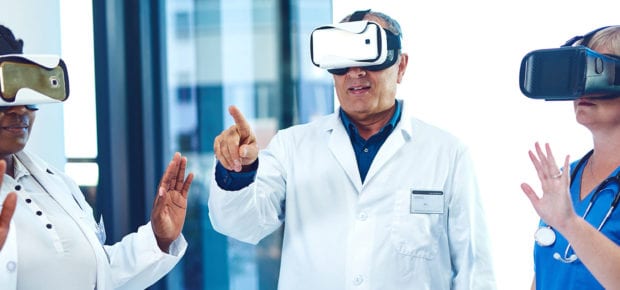April 30, 2020
“I feel like I’m playing PAC-MAN,” IEEE Member Todd Richmond told a grocery store employee when food shopping recently. “I turn down a row, see people, turn back around and immediately head for another aisle.”
The grocery shopping experience, like the rest of the world, has been turned upside-down by the COVID-19 pandemic. But as we navigate through this unprecedented crisis, many technologists like Richmond have one eye on the future.
“I can imagine an augmented reality app being developed in the future that helps people deal with social distancing more efficiently,” says Richmond. “In theory, such an app would essentially map out where a user is in relation to where other users are – it would pull data on higher risk areas based on population density and other factors, enabling the user to navigate around a particular area more safely.”
Uniquely challenging times call for uniquely innovative solutions, such as the one Richmond outlined. Here are some other ways that augmented reality and virtual reality (AR/VR) technologies can help combat COVID-19 and other challenges moving forward.
VR is Empowering Doctors and Care Providers
One thing that sets COVID-19 apart from other viruses impacting the respiratory system is the damage it can do to the lungs of those infected.
Healthcare experts have found that those infected with the virus sometimes have difficulty breathing, and in serious cases, run the risk of their lungs becoming inflamed. If the respiratory illness worsens, a pneumonia can develop that affects all areas of the lungs.
“Virtual reality and 3D imaging technologies can be leveraged to better spot the unique characteristics associated with COVID-19,” IEEE Senior Member Jacob Scharcanski explains. “By making this data – focusing on lung imagery for COVID-19 and other viral infections – available to physicians, we might be able to do a better job of spotting the virus and its impact on patients earlier, which would be extremely beneficial in terms of activating on an appropriate treatment.”
IEEE Member Anderson Maciel notes that immersive technologies have been utilized in medical education for over two decades now.
“Immersive technologies have been leveraged in medicine for some time now,” says Maciel. “Applications range from helping educate physicians prior to delicate surgeries to enabling patients to virtually interact with doctors in an appointment.”
Moving forward, AR/VR technologies are poised to potentially augment care providers’ ability to understand specific illnesses, such as COVID-19, providing unprecedented insight into how to combat them.
Educating and Enabling the Public
“In my opinion, the best application for AR/VR in terms of combatting new, still rather unknown infectious diseases is focused on improving the behaviors that lead to infection and spread,” says Maciel.
“Virtual reality in particular is ideally suited to train average citizens – who don’t have any medical experience and are most likely to unknowingly spread a virus – in everyday behaviors because of the feeling of presence that it provides,” explains Maciel. “People immersed in virtual scenarios tend to behave as they would in the real world, which is not true with other educational methods, such as public service announcements and digital campaigns focusing on informing the public on best practices. Short of placing a citizen in an actual dangerous scenario, virtual reality is the best there is for accurately providing experiential knowledge.”
Beyond education, Maciel highlights how immersive technologies are supporting citizens throughout the COVID-19 pandemic by enabling a sense of normalcy. For those practicing social distancing and remaining home, Maciel says AR/VR can also be used to augment fitness-focused games, enable virtual travel, optimize social gatherings and more.
Richmond also shines a light on AR/VR as a tool to help manage future disruption. “Once multi-person VR and telepresence-focused technologies are further along, the ability to connect in shared virtual spaces will be a massive shift in how we connect remotely.”
With social distancing measures still firmly in effect, the type of multi-person VR platform Richmond outlined would go a long way in keeping us connected – yet apart.





 Meaningful Momentum or Running in Place?
Meaningful Momentum or Running in Place? AI Through Our Ages
AI Through Our Ages Liquid Infrastructure: Our Planet's Most Precious Resource
Liquid Infrastructure: Our Planet's Most Precious Resource The Impact of Technology in 2025
The Impact of Technology in 2025 Quantum and AI: Safeguards or Threats to Cybersecurity?
Quantum and AI: Safeguards or Threats to Cybersecurity? Why AI Can't Live Without Us
Why AI Can't Live Without Us Bits, Bytes, Buildings and Bridges: Digital-Driven Infrastructure
Bits, Bytes, Buildings and Bridges: Digital-Driven Infrastructure Impact of Technology in 2024
Impact of Technology in 2024 Emerging AI Cybersecurity Challenges and Solutions
Emerging AI Cybersecurity Challenges and Solutions The Skies are Unlimited
The Skies are Unlimited Smart Cities 2030: How Tech is Reshaping Urbanscapes
Smart Cities 2030: How Tech is Reshaping Urbanscapes Impact of Technology 2023
Impact of Technology 2023 Cybersecurity for Life-Changing Innovations
Cybersecurity for Life-Changing Innovations Smarter Wearables Healthier Life
Smarter Wearables Healthier Life Infrastructure In Motion
Infrastructure In Motion The Impact of Tech in 2022 and Beyond
The Impact of Tech in 2022 and Beyond Cybersecurity, Technology and Protecting Our World
Cybersecurity, Technology and Protecting Our World How Technology Helps us Understand Our Health and Wellness
How Technology Helps us Understand Our Health and Wellness The Resilience of Humanity
The Resilience of Humanity Harnessing and Sustaining our Natural Resources
Harnessing and Sustaining our Natural Resources Creating Healthy Spaces Through Technology
Creating Healthy Spaces Through Technology Exceptional Infrastructure Challenges, Technology and Humanity
Exceptional Infrastructure Challenges, Technology and Humanity The Global Impact of IEEE's 802 Standards
The Global Impact of IEEE's 802 Standards Scenes of our Cyber Lives: The Security Threats and Technology Solutions Protecting Us
Scenes of our Cyber Lives: The Security Threats and Technology Solutions Protecting Us How Millennial Parents are Embracing Health and Wellness Technologies for Their Generation Alpha Kids
How Millennial Parents are Embracing Health and Wellness Technologies for Their Generation Alpha Kids Space Exploration, Technology and Our Lives
Space Exploration, Technology and Our Lives Global Innovation and the Environment
Global Innovation and the Environment How Technology, Privacy and Security are Changing Each Other (And Us)
How Technology, Privacy and Security are Changing Each Other (And Us) Find us in booth 31506, LVCC South Hall 3 and experience the Technology Moon Walk
Find us in booth 31506, LVCC South Hall 3 and experience the Technology Moon Walk Virtual and Mixed Reality
Virtual and Mixed Reality How Robots are Improving our Health
How Robots are Improving our Health IEEE Experts and the Robots They are Teaching
IEEE Experts and the Robots They are Teaching See how millennial parents around the world see AI impacting the lives of their tech-infused offspring
See how millennial parents around the world see AI impacting the lives of their tech-infused offspring Take the journey from farm to table and learn how IoT will help us reach the rising demand for food production
Take the journey from farm to table and learn how IoT will help us reach the rising demand for food production Watch technical experts discuss the latest cyber threats
Watch technical experts discuss the latest cyber threats Explore how researchers, teachers, explorers, healthcare and medical professionals use immersive technologies
Explore how researchers, teachers, explorers, healthcare and medical professionals use immersive technologies Follow the timeline to see how Generation AI will be impacted by technology
Follow the timeline to see how Generation AI will be impacted by technology Learn how your IoT data can be used by experiencing a day in a connected life
Learn how your IoT data can be used by experiencing a day in a connected life Listen to technical experts discuss the biggest security threats today
Listen to technical experts discuss the biggest security threats today See how tech has influenced and evolved with the Games
See how tech has influenced and evolved with the Games Enter our virtual home to explore the IoT (Internet of Things) technologies
Enter our virtual home to explore the IoT (Internet of Things) technologies Explore an interactive map showcasing exciting innovations in robotics
Explore an interactive map showcasing exciting innovations in robotics Interactively explore A.I. in recent Hollywood movies
Interactively explore A.I. in recent Hollywood movies Get immersed in technologies that will improve patients' lives
Get immersed in technologies that will improve patients' lives